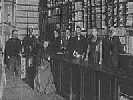
|

Sensing and Modeling Dynamic Social Networks |
|
 CSE Home CSE Home |
 About Us About Us |
 Search Search |
 Contact Info Contact Info |
|
OverviewThe structure and dynamics of social networks are of critical importance to many social phenomena, ranging from organizational efficiency to the spread of knowledge and disease. The study of such networks has spawned numerous research conferences and even a series of rapidly growing start-up companies providing software tools for social networking. Academic research in social networks has an abundance of interesting and important questions, but has been faced with a paucity of data rich enough to answer many of these questions. Using a rich new data source, we consider some questions on the dynamics of social networks.
We take innovative approach to learning the structure and dynamics of social networks: using sensing and communications tools together with artificial intelligence techniques to unobtrusively study large populations of interacting humans over extended periods of time. This approach will addresses questions applicable to research ranging from ubiquitous computing to machine learning and perception to human-computer interaction.
Answering these questions will have significant impacts, not only on the computer science and social science research literature, but also by adding value to applied endeavors such as designing public spaces and office environments, and developing computer collaboration tools. Publications
Towards the Automated Social Analysis of Situated Speech Data
Learning Hidden Curved Exponential Random Graph Models to Infer Face-to-Face Interaction Networks from Situated Speech Data
Conversation Detection and Speaker Segmentation in Privacy-Sensitive Situated Speech Data
Capturing Spontaneous Conversation and Social Dynamics: A Privacy Sensitive Data Collection Effort
A Privacy-Sensitive Approach to Modeling Multi-Person Conversations
Towards Activity Databases: Using Sensors and Statistical Models to Summarize People's Lives.
Contact InfoFor more information, please contact Danny Wyatt:
|
|||||||||||||||||||||
|
Computer Science & Engineering University of Washington Box 352350 Seattle, WA 98195-2350 (206) 543-1695 voice, (206) 543-2969 FAX [comments to Danny Wyatt] | |